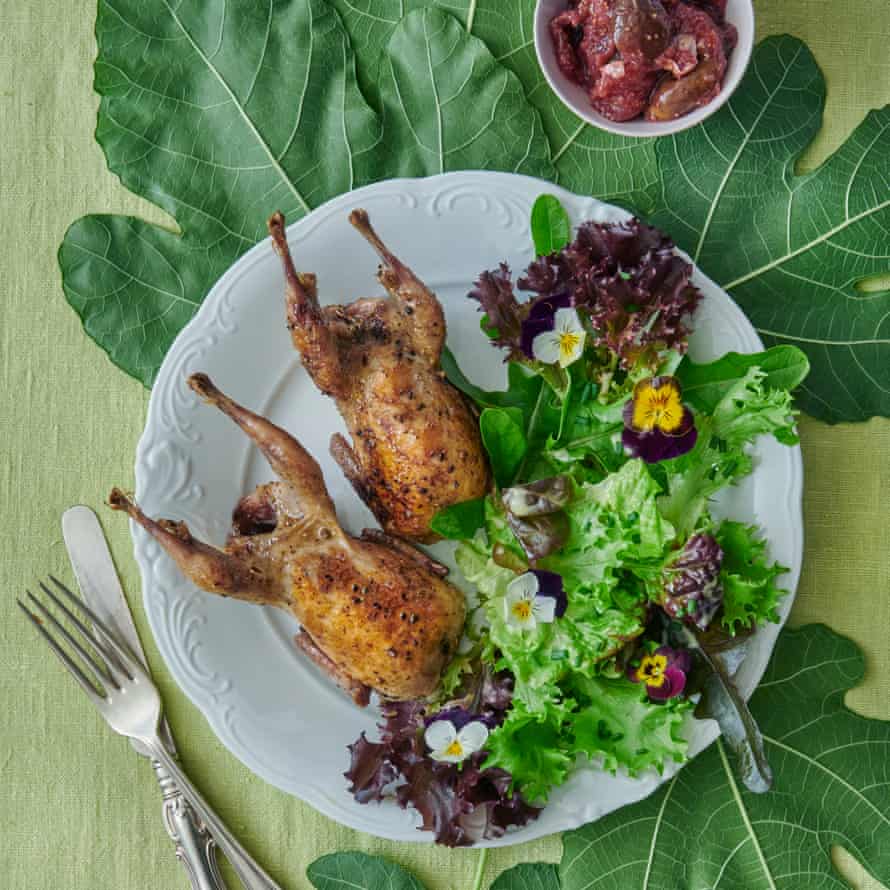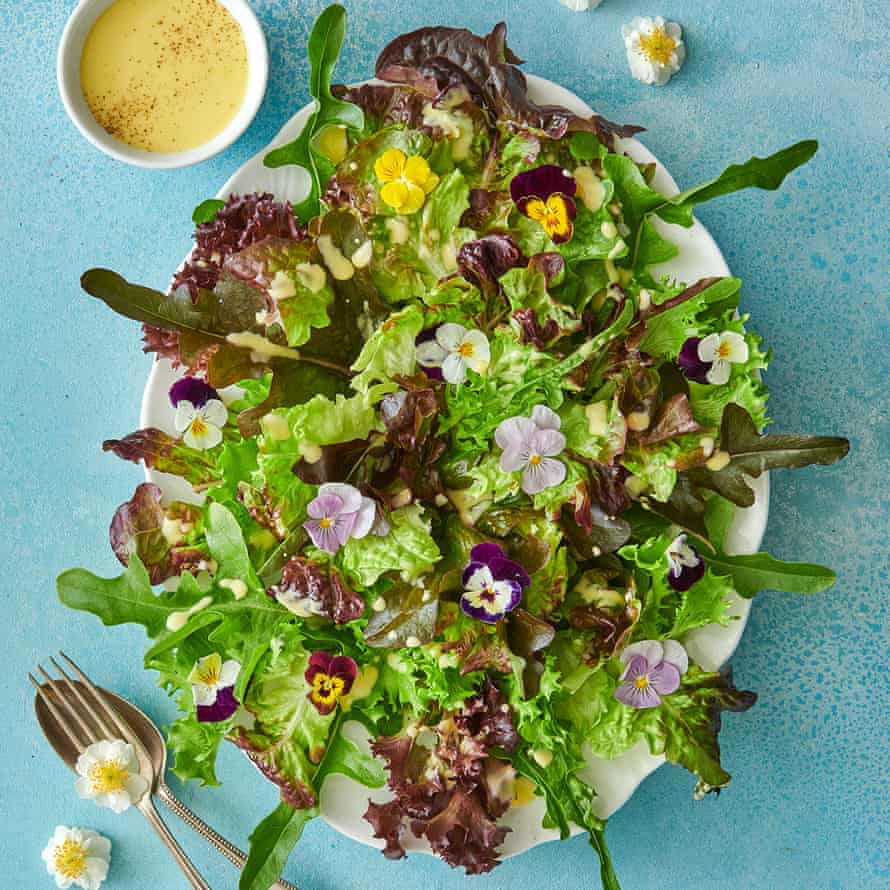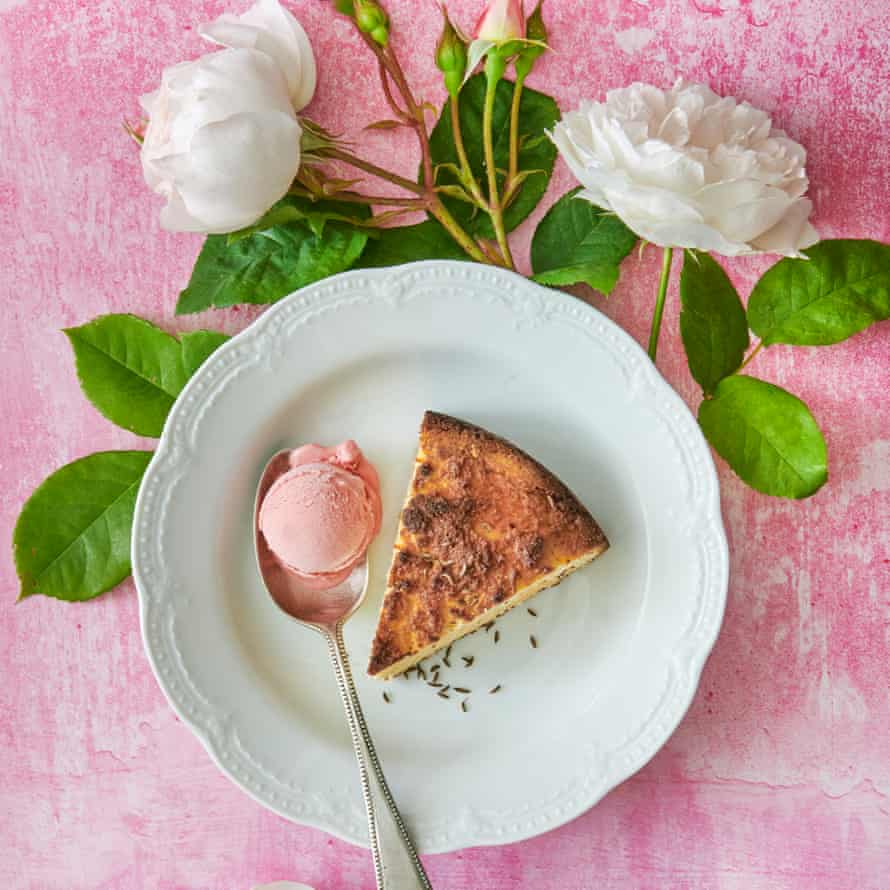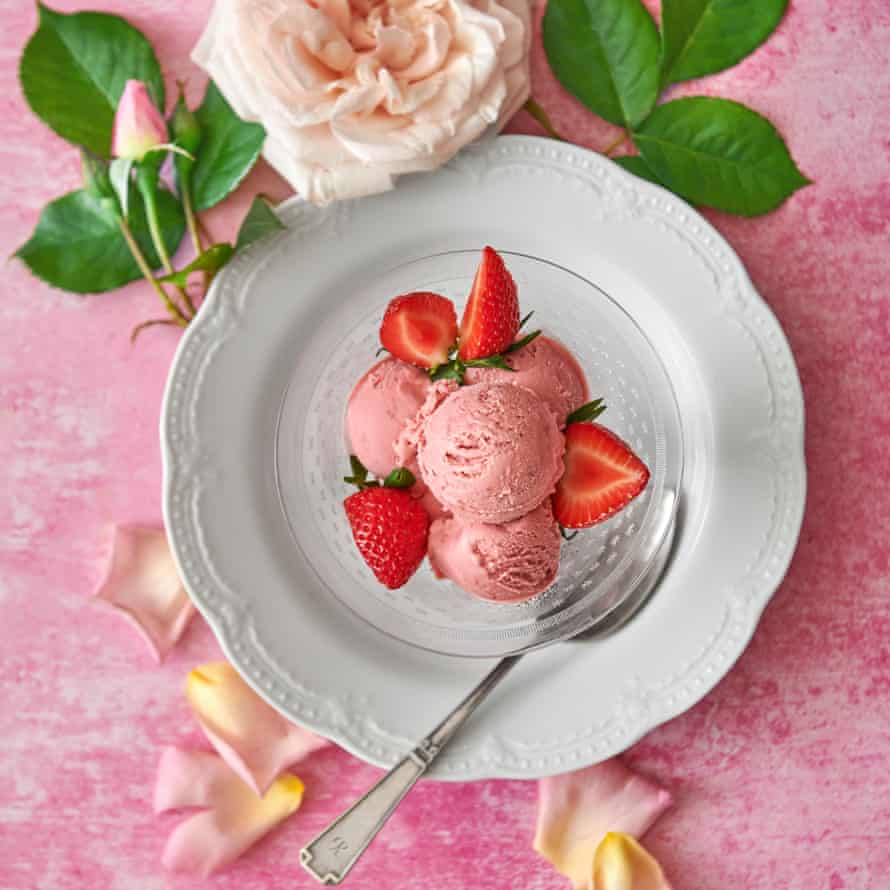There is a loving, odd-couple element to chef Skye Gyngell and her grower Jane Scotter. Theirs is a cook-farmer relationship, more commonly seen in California with, say, Chez Panisse or David Kinch’s Manresa restaurant and Love Apple Farm, but near unheard of in the UK.
We’re Facetiming while they’re at Fern Verrow, Scotter’s market garden in Herefordshire, where Gyngell is combining one of her seasonal visits with an OFM photoshoot. The pair have worked together since 2014, when Gyngell left Michelin-starred Petersham Nurseries in Richmond to open Spring in Somerset House, off the Strand in London.
“I had been beetling down the M4 every Friday night for 15 years,” says Scotter, who had been selling her biodynamic produce at south London’s Spa Terminus. “I’d wanted to stop doing that for a while.” She had been unwell and had to close her stall just a week before Gyngell approached her. “Skye’s proposal probably saved my life,” she says. “Her reputation with produce was a big factor. Plus, she approached us with great enthusiasm and passion, which could not be resisted.”
Seven years later, Fern Verrow and their smaller growing operation to supply Hampshire hotel Heckfield Place – where Gyngell is culinary director – has 450 fruit and vegetable beds over 16 acres producing 60 tonnes of biodynamic food for the restaurants. Plus a new Spring To Go shop in Notting Hill’s swish Ledbury Road.
“I think we were both quite nervous at the beginning,” says Gyngell. “We are both perfectionists and often choose the path of difficulty rather than ease or compromise. But over the years, what is grown at Fern Verrow has defined the way we cook. It’s simplified and purified it.”
I leave them rhapsodising over flowering beans they’d spotted earlier in the day and how they’ll cook and look on the menu.
Cucumber and buttermilk soup

This sings of summer almost like nothing else I know – cool, clean and green in flavour with a pleasant and thirst-quenching acidity lent by the buttermilk. Its a favourite lunch dish when the weather is warm enough to sit outside. There is genuinely no cooking involved, takes no more than 10 minutes to prepare and should be made as close to serving as possible to ensure it maintains its clean, pure flavour.
Serves 4
For the soup
long green cucumbers 2
buttermilk 400ml
sea salt and freshly ground black pepper
cucumber pickle optional (see recipe below)
garden herbs 1 tbsp each of chervil, dill, mint, basil
extra virgin olive oil for serving
For the cucumber pickle
small pickling cucumbers 1kg
sea salt 90g
caster sugar 100g
good quality white wine vinegar 700ml
fresh bay leaf 1
red chilli 1
coriander seeds 1 tbsp
yellow mustard seeds 1 tbsp
fresh dill a handful, coarsely chopped
To make the pickled cucumber, wash and pat dry the cucumbers. Slice into fine rounds – a mandoline is perfect for this. Place them in a colander and layer with the salt. Cover and weigh down for one hour, drain away the excess liquid and rinse.
Place the sugar, vinegar, bay leaf and chilli in a saucepan and put on a low heat. Once the sugar has melted, turn up the heat to a simmer for a couple of minutes or so.
Pack the cucumber slices into sterilised jars, add the spices and chopped dill and pour over the hot pickling liquid. Store in a cool, dark place, then in the fridge once opened.
For the soup, put four soup plates in the fridge to chill. Peel the cucumbers and slice in half lengthwise, scrape out the seeds using a teaspoon, then chop into 2cm pieces. Place the chopped cucumber into a blender with the buttermilk and puree until smooth. Season with salt and pepper and place in the fridge to thoroughly chill.
Serve in the chilled soup plates with a spoonful of pickled cucumber, if using. Scatter the herbs over the top and finish with a drizzle of extra virgin olive oil.
Succotash with cornbread

I love making succotash in high summer when the corn is ripe and sweet. It’s delicious on its own but is also a wonderful fish or chicken. The key ingredients are beans and corn but you can add anything else you have to hand. We like to serve it with a little sour cream or creme fraiche and sometimes a little fresh tomato salsa.
Serves 4
For the succotash
extra virgin olive oil 2 tbsp
fresh corn 4 ears, shucked
sea salt 1 tsp
red onion 1 medium, chopped
green chilli 1 medium, chopped into fine rounds
red pepper 1, chopped into 1cm pieces (seeds and pith removed)
garlic 2 cloves, crushed
cooked butter beans 180g
cucumbers 2 small, deseeded and chopped into 2cm pieces
cooked green beans a handful, chopped into 2cm pieces
tomato 1 large ripe, roughly chopped
unsalted butter 40g
lime juice of 1
basil 1 bunch, leaves only
coriander 1 bunch, leaves only
flat-leaf parsley 1 small bunch, leaves only
cayenne pepper 1 tsp
sour cream to serve
For the cornbread
plain flour 150g
cornmeal 150g
sugar 1 tbsp
baking powder 2 tsp
sea salt ½ tsp
buttermilk 360ml
organic free-range eggs 2
unsalted butter 375g, melted and cooled
clear honey 1 tbsp
sea salt
To make the cornbread, preheat the oven to 200C fan/gas mark 7. Lightly butter a 23cm cast iron skillet or baking dish – place on the middle shelf of the oven to heat up while you prepare the batter.
In a large bowl whisk together the flour, cornmeal, sugar, baking powder and salt. Make a well in the centre and add the buttermilk and eggs. Mix together well to combine, then add in the slightly cooled, melted butter. Mix again lightly but don’t over mix.
Carefully remove your hot skillet from the oven and pour in the batter. Bake until the cornbread begins to brown on top and a toothpick comes out clean when inserted in the centre (about 20-25 minutes) . Remove from the oven and brush with the honey, sprinkle with salt and allow to cool in the pan for 10 minutes before slicing.
To make the succotash, place the olive oil in a large, heavy-based pan over a medium heat. Add the corn and a good pinch of sea salt. Cook, stirring every minute or so until the corn begins to turn golden on the edges, about 5 minutes. Turn the heat down to medium-low and add the onion, chilli, red pepper and another good pinch of salt. Stir well to combine and cook for a further 5 minutes or until the onion has begun to soften. Now add the garlic, butter beans, cucumber and green beans, and cook – just to warm through. Finally, turn up the heat slightly and add the chopped tomato, butter, lime, herbs and cayenne. Stir really well – the butter will give a lovely, slightly creamy texture. Check for seasoning, spoon into warm bowls, adding a tablespoon of sour cream to each one, and serve alongside the cornbread.
Spice-rubbed roasted quail with fig and rose-petal jam

Quail is a versatile bird that absorbs flavour beautifully. Here the gently spiced and well seasoned skin works really well with the sweet fig jam. Allow two birds per person.
Serves 4
quail 8
salt 1 tbsp
olive oil 1½ tbsp
For the jam
fresh ripe figs 1kg, stemmed and quartered
sugar 50g
sweet wine 70ml (Riesling or dessert wine)
salt a good pinch
rose water 1 tsp
rose petals 12, unsprayed, sweet smelling, or 8-10 dried readymade
For the spice mix
cardamom pods 2, seeds extracted
cumin 1 tsp
coriander seeds 1 tsp
fennel seeds 1 tsp
star anise 2
dried red chilli 1, crumbled
First make the jam. You can do this well in advance. Combine the figs, sugar and wine in a saucepan, add the salt and cook over a medium heat uncovered, stirring occasionally until the wine is cooked out and the figs are very soft and falling apart, it should take about 25-30 minutes. It’s a loose jam and you should get a lovely outcome from this cooking time. (You can do the plate test but it shouldn’t be necessary.) Remove from the heat and allow to cool. Stir in a teaspoon of rose water and the torn rose petals. Store the jam in sterilised jars and in the fridge once open. There’ll be plenty of jam and it’s delicious on toast or even as an accompaniment to scrambled eggs.
If possible, a day ahead, sprinkle the quail lightly all over with salt, cover loosely and leave in the fridge overnight.
To prepare the spice mix, put all the spices into a small frying pan over a medium heat. Warm through, jiggling the pan once or twice for about a minute until the seeds begin to jump and pop. Immediately take off the heat. Using a pestle and mortar, grind the spices along with the dried chilli until you have a fine textured spice mix.
Rub the quail all over with the olive oil then scatter the spice mix evenly over each bird and gently rub into the skin using your fingers. Cover loosely and leave to marinate for an hour or two.
Preheat the oven to 200C fan/gas mark 7. Heat up a large, dry frying pan over a high heat. Brown the birds in batches, allowing one minute on each side, turning once only. Place the browned quail into a roasting pan, put it on the middle shelf of the oven and roast for 8 minutes. The flesh should be slightly firm to the touch and the juices running clear.
Remove from the oven and allow to rest for 10 minutes before serving. Serve with a tablespoon of jam on the side, and the leaves and elderflower dressing (see below).
Leaves with elderflower dressing

This is a very light, clear and bright dressing that works best with soft summer leaves. I like to add a tangle of summer herbs such as chervil, basil, tarragon and chives. Use little gem, butter or oak leaf for this salad.
Serves 4
summer leaves a selection, such as little gem, butter, oak or iceberg
herbs a mix of chives, basil and tarragon, leaves only, 20g in total
edible petals a scattering, if you have them
For the dressing
egg yolks 2
clear, good quality honey 1½ tsp
elderflower cordial 1½ tsp
lemon juice of ½
sea salt a pinch
mild tasting extra virgin olive oil 200ml
creme fraiche 2 tbsp
water 1 tbsp
You can make this dressing by hand but the simplest and quickest way is in a food processor. Place the yolks, honey and elderflower cordial in a food processor, squeeze over the lemon juice and add a pinch of salt. Turn the motor on and slowly drizzle the oil through the funnel in the top (you are essentially making a mayonnaise). Once all the oil is incorporated, turn off the processor and spoon the dressing into a bowl. Stir in the creme fraiche and add a tablespoon of water to thin to a pouring consistency. Chill in the fridge until ready to use. The dressing will last well in the fridge for a few days.
Separate the leaves, wash and pat dry. Place in a bowl large enough to comfortably hold and dress them, scatter over the herbs and petals. Drizzle over a little olive oil and squeeze over a few drops of lemon juice (just for brightness rather than acidity). Season with salt and a little freshly ground black pepper, and toss together using clean fingers.
Arrange on one large plate or divide between 4 plates and lightly drizzle over the dressing. Serve at once.
Seed cake

Seed cake is a beautiful and very traditional British cake that I first came across in Mrs Beeton’s Book of Household Management. It is flavoured with caraway, and we love to serve it in the summer months with any soft fruit ice-cream.
Serves 8-10
self-raising flour 175g
ground almonds 300g
caster sugar 45g
unsalted butter 110g
honey 2 tbsp
organic eggs 3
amaretto 1 tbsp
caraway seeds 3 tsp, lightly toasted and coarsely crushed
Prepare a 23cm cake tin, by brushing with butter and lining with parchment paper. Sift the flour into a mixing bowl. Place the ground almonds in another mixing bowl with the sugar. Cream the mixture together on a low speed for 2 minutes. Add the butter and beat for a further 5 minutes, mix in the honey, then add the eggs one at a time, beating until each one is fully incorporated before adding the next. Add the amaretto and crushed caraway seeds, and finally fold in the flour. Pour into the prepared cake tin and smooth the top. Bake for 25 minutes or until the cake is golden and springs back when pressed. Transfer to a cooling rack.
To serve, slice the cake into 2cm slices, then into little triangles. Place a scoop of ice-cream into a bowl and arrange the seed cake alongside. Serve immediately.
Strawberry ice-cream

Ice-cream is one of the things I take the greatest pleasure in making – it is a beautiful way to capture the flavour of fruit when it is in the height of the season and at its peak. It would be impossible to pick a favourite but there is something about strawberry ice-cream that I find incredibly comforting and reminiscent of childhood.
Serves 8
organic free-range egg yolks 6
caster sugar 120g
double cream 450ml
whole milk 150ml
vanilla pod 1, split in half lengthwise
fresh strawberries 750g, hulled and halved
caster sugar 140g
lemon juice a few drops
Start by making the ice-cream base. Place the yolks and the 120g of sugar in a clean bowl, whisk well to combine. Pour the cream and milk into a heavy-based pan and place over a low heat. Scrape the vanilla seeds from the pod and add them to the creamy mixture, along with the empty pod. Slowly bring to just below the boil, remove from the heat and allow to infuse for 10 minutes before pouring over the egg yolks and sugar, stirring with the whisk as you do so.
Return the custard to the saucepan and place over the lowest possible heat. Stir gently and patiently until the custard begins to thicken, this will take about 5-6 minutes. It should be thick enough to coat the back of a wooden spoon – draw a finger along the back of the spoon, it should leave a clear trace.
As soon as the custard thickens, remove from the heat, pour through a strainer into a clean bowl and allow to cool. Discard the vanilla pod or better still wash and dry it and add to a jar of sugar. Once cooled, the custard is ready to use as your ice-cream base.
Wash the strawberries and place in a food processor along with the 140g of caster sugar and a couple of drops of lemon juice. Puree until completely smooth. Stir the strawberry puree through the cool custard, stirring well to combine.
You are now ready to freeze your ice-cream. Place into an ice-cream machine and follow the manufacturer’s instructions, or simply pour into a square baking dish. Place in the freezer for 90 minutes, then remove and whisk the mixture, scraping the sides of the pan and breaking up any frozen chunks. Return to the freezer for a further 45 minutes, then repeat the process, returning to the freezer quickly. Repeat again after 30 minutes. Repeat twice more at 30-minute intervals. The more you whisk the lighter and fluffier the final texture will be. The whole process should take about 3 hours, at which point you can cover and place in the freezer until you are ready to use.
Hazelnut meringue cake

Serves 10
hazelnuts 300g, toasted
cornflour 2 tbsp
caster sugar 225g
egg whites 210g (about 7 eggs)
cream of tartar 2 tsp
salt a pinch
caster sugar 40g
double cream 250ml
ripe, sweet raspberries 300g
Preheat the oven to 155C fan/gas mark 4. Prepare two 23cm cake tins with removable bottoms, by brushing with butter and lining with parchment paper.
Place the hazelnuts, cornflour and the 225g of caster sugar in a food processor. Pulse until the nuts are a medium to fine consistency.
Place the egg whites with the cream of tartar and a pinch of salt in a large, very clean bowl. Whisk until soft peaks, then slowly add the 40g of sugar and whisk until stiff and glossy.
Gently fold in the nuts and place in the prepared cake tins. Bake for 25 minutes. Remove from the oven and set aside to cool. Remove from the cake tin when they are completely cool.
Place the cream in a bowl and whisk until soft and pillowy.
Spread the softly whipped cream on one side of the meringue and then arrange the raspberries on top making sure they are placed very close and snugly together. Lay the second meringue on top. Wrap in parchment or foil and gently place a weight evenly on top. Place in the fridge to chill for 2 hours before cutting and serving with a little extra cream and raspberries.
Skye Gyngell is chef-owner of Spring, Lancaster Place, London WC2R and Spring To Go, 66-68 Ledbury Road, London W11. Jane Scotter is owner of Fern Verrow farm, Herts
